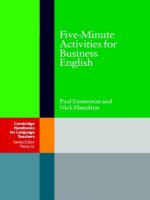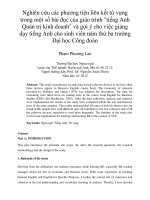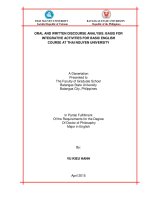Suggested warm up activities for teaching english 10
Bạn đang xem bản rút gọn của tài liệu. Xem và tải ngay bản đầy đủ của tài liệu tại đây (242.83 KB, 21 trang )
Part 1: Introduction
1. Rationale
In the global trend, English also plays an important role in every scene.
Because of this, the demand for English is not increasing.
In fact, the British market is considered to be one of the hottest universities
in the world. Is your teacher a teacher for every student? Who is your child's
teacher and goes to this school?
Throughout the four years in the Secondary School Board, the outlook for
every experience is that if students participate in a warm-up activity
(warm_up activity) Beginning with the beginning of the world, education is
going to be a lot better. Is it possible to get warm-up activity and proper
performance? This often involves counting the length of time when the hand
reaches the hand.
Asked to get away from it. Composing the experience of the experience with
the voice: Some ideas about how to work in a classroom. English 10
(Suggested warm_up activities for teaching English 10) I would like to share
a few experiences that can help you make the most of your English lessons in
English.
1.1. purpose of developement
For the reasons given above, this article may give a clue about the high
temperature and wind speed in Britain, especially the English 10 Small plates:
- Give to one more comprehensive English 10
- Provide a few basic facts about the role of the lagoon operation.
- Recognize the impact of climate change on public health.
1.2. Objects of study
Suggested Warm-up activities from unit 1 to unit 16
Warm-up activities are so popular every day, every meeting is different. Thus,
the material is not entirely attributable to the warm_up category.
1
As a result of the source of the data, the experience, the problem, the article
only mentions the smallest possible number of possible combinations in the
answer English10.
1.3. Method of study.
By substituting the start of a thread with a thread, the wrestler can use the
same Warm-up activity for different purposes.
* Warm-up to leave students in the classroom:
With the activities of the school, the lecturers can "learn" the language, with
the ability to create students at the university level:
- Use pictures
- KEY to move
- Missing or misspelled 1
- The meter was not bulky and the students'
- Provides directly or indirectly to the students
- Allows you to edit any topics at a time.
- Use fresh air to drain air
- The consultant must prepare a plan for the project to be implemented, in a
timely manner,in a coherent manner.
- Activities must be short, simple
- Actions should be consistent
- Actions should be based on students’ strengths
- The activities in the project should be a long-term, sustainable solution for
students.
3. The results of the Warm-up survey on the effect of Warm-up at the level of
the 10th high school in Trieu Son Upper Secondary School Number 2:
To illustrate how effective the subjects are for learning, I conducted a survey
of students in10C3, 10C4, 10C6. In addition to the output, I also apply this
experience initiatives.
2
Part 2: CONTENTS
2.1. Basic logic of the experience initiatives
English 10 was re-introduced to the humid conditions program from 20162017 and the raw materials were recycled in the factory. Outdoor and outdoor
activities. After 3 years of doing this, English 10 has been very popular, but it
is difficult to find words for parents and students. .
At 10 points, you have 16 unit units (You, me, education, community, nature,
recreation and People and place) at the same level as the numbers and the
numbers. The age of the students. The locks are available so that they can fit
in the correct shape, in the same way that the children are saving the
information for the classroom, the classroom This is for children with many
specialties needed.
Language Focus is designed to fit the needs of the students. For example, the
name of the line (V-ing) and the source code (to V), which indicates whether
the student needs to be placed after each input or scaling. V-ing or To-V.
Unable to reach the Glossary effect, it can be found that the information about
the new and improved graphics in the window, the wind I am more
comfortable in preparing myself.
At the point of view of the units, though, the units are only compatible with
the real numbers of the students, but the number of units in the unit is equal.
Make ends meet, meet one's wish ...
In addition, in a number of years, the authors of the book, are unconcerned
about the contents of the book, and the book itself. You can tell when to write
a song.
Some of the contents of the application are also very small, but they are not
included in the shipping section.
See the tutorials and pointers on the top of the page, as well as many other
English tutorials on the other hand when completing the program. And this
3
article discusses the advantages and disadvantages of point-of-entry in the
external and general 10 language.
2.2. Real situation of problems before applying the experience initiatives
Although English has become a main subject at school, the motivation of its
useful benefit hasn’t been concerned about very much. The vital reasons are
the lacks of materials and facialities of teaching, furthermore, the qualitiy of
teaching or learnig is not appreciated, in other way, It has not apealed to the
passinate interest of the students
According to the results of the survey, 90% of students in the Warm-up
activities and more than 80% in the class returned to school children as a
physical therapist. It's good to see new beginnings. Approximately 5% of the
respondents checked their identity at start of new polls and 5% did not
otherwise agree or disagreed.
Thus, it is clear that Warm-up is going to get the best results for students.
Students are more organized than English teachers, compared to English
teachers who start with other hard-working volunteers.
Before the study:
Class
Not very
10C3
10C4
10C6
well
30/45
21/43
24/55
Students’ number of doing tasks
%
well
66.6
48.8
43.6
2.3. Methods applied to sovle problems
Unit1: A day in the life of…….
a. Lesson A: Reading
Name: Describing pictures
Type : class work
Materials: Pictures
Time : 3-5 mins
Procedure
4
15/45
22/43
18/55
%
33.3
51.1
32.7
- Hang on some pictures in turn and ask students to say out what they can
see.
- ask students to guess the content of the lesson
b.Lesson B: Speaking
Name: matching words
Type: group work
Materials: poster, large papers, board
Time: 5 mins
Procedure:
- Devide the class into 2 groups
- Provide each group with 1 large and 1 board
- Give instruction and time allotted
- Check groups’ work and declare the winner
Subjects in English
Subjects in Vietnamese
a. Van
1. Civic Education
2. Technology
b. Toan
3. Maths
c. §Þa ly
4. phyics
d. Hoa häc
5. geography
e. Tieng Anh
6. History
f. Cong dan
7. Chemisrty
g. Lich su
8. Physical Education
h. The dôc
9. English
i. Cong nghe
10.Biology
j. Vat ly
11.Literature
k. Tin hoc
12.Infomatics
l. Sinh hoc
c. Lesson C: Listening
Name: Network(
5
Type: class work
Material: board, chalk
Time: 3 mins
Procedure:
- write the key word on the board
- ask sts to think of the related words and say in English
- Lead in the lesson by some guiding question:
+ Do you like travelling by cyclo?
+ Do you think Cyclo_ driver is an easy work?
d. Lesson D: writing: Writing a narrative
Name: Telling a story
Type: Individual work
Materials: Nothing
Time: 3- 5 Mins
Procedure:
- ask sts to think of the most impressed story that they witnessed or heard
- call on one advanced to tell in front of the class( Encourage him/ her to
use English)
- Give some other guiding questions:
+ What items are mentioned in his/ her story( Time, event, place……)
+ Which tense is used in the story?
e. Lesson E: Language Focus:
Name: Describing pictures
Type: Class work
Materials: Pictures, chalk
Time: 2-3 mins
Procedure:
- Hang the 2 pictures on the boarh and ask students to speak out what
they can see in these pictures.
- Write the 2 key words on the board
- Call on some students to read the words
- Write the phonetic forms of them and read the words aloud several
times
Unit 2: School talks
a.Lesson A: Reading:
Name: Slap the board
Type: Group work
6
Materials: stick cards
Time: 3- 5 Mins
Procedure:
- divide the class into 2 groups
- Ask each group to send 5 presentatives and set in a queue
- Provide each group of students 7 stick cards and give instruction
- Read aloud sentence by sentence
- Give feedback
- Declare the winner
7 Suggested sentences:
+ I often play ………online when I have free time
+ After the school year, I’ ll go on a summer…….
+ Soccer and badminton are my favourite……….
+ Do you usually watch…….at 6p.m everyday?
+ What is the ……….like today?
+ Students have to………hard for the exam.
+ My ………….is collecting stamps.
Keys : games/ holiday/ sports/ film/ weather/ study/ hobby
b. Lesson B: Speaking
Name: Jumbled words
Type: class work
Materials: Posters
Time: 5 mins
Procedure:
- Hang on the posters
- Give instruction and time allotted
- Check with the whole class
Jumbled words:
+ nice/ been/ has/ it/ meeting/ you
+ later/ you/ see/. Goodbye.
+ Hello. Are/ you/ how
+ Sorry, go/ to/ have/ got/ I. you/ catch/ later
Keys:
+ It has nice been meeting you
+ Goodbye. See you later
+ Hello. How are you?
+ Sorry, I have got to go. Catch you later.
c. Lesson C: Listening
Name: Missing words
Type: group work
Materials: Posters, chalk
Time: 5 mins
Procedure:
7
-
Divide the class into 2 teams
Give instruction
Hang on the posters
Call on 2 representatives of the 2 groups to come to the board and write
down the key words
Poster:
+ The duty of students is to S_ _ _ _
+ In summer, my family often go to the B_ _ _ _.
+ 30th April is Hoa’s birthdayP_ _ _ _.
+ My hobby is T_ _ _ _ _ _ _ _ _ around the world.
+ He invites me to go out for a D_ _ _ _.
Suggested answers: STUDY/ BEACH/ PARTY/ TRAVELLING/ DRINK
Unit 3: People’ s background
a.Lesson A: Reading
Name: Game: Who am I( three persons)
Type: group work
Materials: pictures, some pieces of paper
Time : 5 mins
Procedure:
- Divide the class into two teams
- Give instruction
- Read aloud the three clues for one person in turn
- Declare the winner
• Who am I
+ I was born in Nghe An
+ I am the greatest leader of Vietnam
+ My birthday is May 19th 1890
UNCLE HO
• Who am I?
+ I live in America
+ My name begins with letter B
+ I am the boss of the company Microft
BILL GATES
8
• Who am I?
+ I am a famous female scientist.
+ I was born in Germany
+ My name begins with letter M
MARIE CURIE
b.Lesson B: Speaking:
Name: Listing words beginning with the letter I
Type: Group work
Materials: Large papers, board
Time: 3-5 mins
Procedure:
- Divide the class into two teams
- Deliver each group with one large paper and one board
- Ask students to write down the words beginning with I in three minutes
- Check with the whole class and declare the winner
c. Lesson C: Listening
Name: Name some Olympic champions
Type: class work
Material: none
Time: 2-3 mins
Procedure:
- Give the question: “ Can you name some famous Olympic champions
in the world?”
Suggested names: Michael Phelps ( swimming – 2008), Nastia
Liukin( Athletes- 2008)…………
d. Lesson D: Writing: Fill in a form
Name: Matching
Type: group work
Materials: posters, board pens
Time: 3-5 mins
9
Procedure:
- Divide the class into two teams
- Provide each group with one poster containing the matching task
- Ask sts to match in three mins
- Hang groups’ work on and check with the whole class
- Declare the winner
A
1.
2.
3.
4.
5.
6.
7.
Name
date of birth
place of birth
school attended
exams passed
previous job
interests
a.
b.
c.
d.
e.
f.
g.
B
Quynh giang village
Phan Boi Chau
5/ 10/ 1983
Music and dancing
Private tutor
English
Cao Thi Hue
e. Lesson E: Language Focus
Name: Drawing pictures
Type: classwork
Materials: chalk, board
Time: 3 mins
Procedure:
- draw some unclear things on the board and ask sts to guess what the
teacher is going to draw next
- complete the pictures of three faces with sadness on them
- ask sts these questions:
+ Who are they? Men or Women?--> Men
+ Are they sad or happy?--> Sad
- Write the two words on board and read them aloud three times
- Write the phonetic forms of them and ask sts to read
Unit 4: Special Education
a. Lesson A: Reading
Name: Questionaire
Type: class work
Materials: none
Time: 3 mins
Procedure:
- give questions and ask sts to answer:
+ Can all of you hear/ speak/ see?
+ What are people who can’t hear/ speak/ see called?-THE DISABLED
+ Is it easy or difficult to teach the disabled?
+ May they have normal education?
10
- lead in the lesson : SPECIAL EDUCATION
b . Lesson B: Speaking
Name: Noughts and crosses
Type: group work
Materials: posters
Time: 5 mins
Procedure:
- Divide the class into 2 teams
- Give instruction: each group take 1 turn to choose the number they
like . each number carrries 1 word, the group have to make sentence
with this word.The group which complete 3 sentences on the same
horizontal or vertical line first will be the winner.
- Monitor the game
- Declare the winner
Subjects ( 1)
Activities( 4)
Friends( 7)
Test
(2)
Lower secondary( 5)
Time- table( 8)
Homework( 3)
Break ( 6)
Teachers( 9)
c. Lesson C: Listening
Name: Network
Type: classwork.
Materials: chalk, board
Time:2-3 mins
Procedure:
- write the key word on the board
- ask students to say the name of the school for the disabled in Vietnam
- lead in the lesson
d. Lesson D: Writing
Name: Describing pictures & questions
Type: classwork
Materials: pictures
Time: 3-5 mins
Procedure:
- hang the pictures on and give questions:
+ who are in these pics?
+ how do they feel? Happy or angry?
+what kind of letter do you write if you feel angry with something/
someone? A letter of complaint or a thank- you letter?
- lead in the lesson
11
e. Lesson E: language focus
Name: Using realia
Type: Classwork
Materials: a box, some chalk
Time: 2 mins
Procedure:
- Take a box and ask students what you are holding BOX
- Take some chalk and ask sts what is in your hand CHALK
- Write the two words on Board
- Ask some sts to read aloud the words
- Read aloud the words as modal
- Write the phonetic forms and lead in the lesson
Unit 5: Technology and you
a. lesson A: Reading
Name: Matching words and pictures( names of hardware)
Type; group work
Materials: pictures, stick cards
Time: 3-5 mins
Procedure:
- devide the class into two teams and give instruction
- hang pictures on board
- call on the representative of each group to stick cards with the right
words on the pictures
- declare the winner
b. Lesson B; Speaking
Name; Network
Type: classwork
12
Material: none
Time: 3 mins
Procedure:
- write the key words on Board
- ask sts to say out the names of modern inventions that they know
- lead in the lesson by some more questions:
+ do you have……?
+ what is a/ an………..used for?
c. Lesson C: Listening
Name: describing pictures
Type: classwork
Material: pictures
Time: 3 mins
Procedure:
- hang the pictures on and ask students what the man and the girl in the
picture is doing.
- Lead in the lesson with some questions:
+ are you learning to use computer at school?
+ is it easy or difficult or interesting?
D. Lesson D: Writing:
Writing instructions
Name: questions
Type: classwork
Material: pictures
Time: 3 mins
Procedure:
- Hang the pictures on and ask students what is in the pictures- Public
Telephone
- Give questions:
+ Have you ever used a public telephone?
+ Is it easy or not to use it?
+ can you show me how to use it?
- lead in the lesson
13
e. Lesson E: Language Focus
Name: realia and questions
Type: class work
Materials: books, chalk
Time:2 mins
Procedure:
- take a book and asks students to say what it is-- BOOK
- asks sts what “ Thang 6” in English is JUNE
- write the two key words on Board and read them aloud
- Asks sts to tell the difference in pronouncing these words
- Give the phonetic forms
Unit 6: An Excursion
a. Lesson A; Reading:
Name: describing pics and questions
Type; classwork
Materials: pictures in textbook
Time:3 -5 mins
Procedure:
- asks students to open the textbook and answer the questions:
+ What is picture one about? What can you see in picture…?
+ What do you know about it?
+ Which site do you like to visit best?
14
b. Lesson B: Speaking
Name: completing the picture
Type: classwork
Materials: chalk, board
Time: 3-5 mins
Procedure:
- Teacher draws a horizontal line on the board.
- Asks some sts to come to the board and complete it in their own
opinion
- Praise the st if he/ she can draw a picture of a boat
- If sts can not draw a boat, T has to do it
- Lead in the lesson by some more guiding questions:
+ Have you ever traveled by boat? Do you like it?
+ which place on the boat do you like best?
c. Lesson C: Listening
Name: answer the questions in the textbook
Type: classwork
Materials: textbook
Time: 3 mins
Procedure:
- asks sts to answer the Questions in the part “ Before you listen”
- lead in the lesson
d. Lesson D: Writing:
Name: network
Type: classwork
Materials: chalk, board
Time: 3 mins
Procedure:
- write the keys word on board
- ask sts to speak out types of letter that they know
- lead in the lesson
e. Lesson E: Language Focus
Name: odd one out
Type: group work
Materials: chalk, books
Time: 3 mins
Procedure:
- divide the class into groups
- write the 2 groups of words on board
- ask students to find out the word whose underlined part is pronounced
differently
- give feedback and lead in the lesson
15
• earn, bird, fir, other
• today, nurse, from, of
Unit 7: Mass Media
a. Lesson A: Reading:
Name: listing words beginning with M
Type: groupwork
Materials: large papers
Time: 3-5 mins
Procedure:
- divide the class into 2 groups
- provide each group a large paper and one board
- give instruction
- hang the groups’ work on and check with the whole class
- declare the winner
- lead in the lesson
b. Lesson B: Speaking
Name: Network
Type: classwork
Materials: chalk, Books
Time: 3 mins
- write the key word on board
- ask sts to speak out the names of some Mass media
- lead in the lesson
c. Lesson C; Listening
Name: pictures and questions
Type: classwork
Materials: pictures
Time: 3 mins
Procedure:
- Take the pic and ask sts to say what is in the picture RADIO
- Give some guiding questions:
+ what is it used for?
+ do you often listen to it? When? How many hours a week?
+ which programme on it do you like best? Music or news?
- lead in the lesson
d. Lesson D: Writing
Name: questions
Time: 3 mins
Procudure:
- give questions:
+ can you name some kinds of Mass Media?
+ Which is the most popular?
16
+ what are the advantages and disadvantages of TV?
- Lead in the lesson
e. Lesson E: Language focus
Name: group words
Materials: pieces of papet
Type: groupwork
Time: 3- 5 mins
Procedure:
- divide the class into groups
- give each group a piece of paper with 9 words on it
- ask each group to put the 9 words in 3 columns basing on their phonetic
feature
- lead in the lesson
9 words: buy, boy, enjoy, play, say, toy, kind, type, they
Unit 8: The story of my village:
a. Lesson A: Reading
Name: comparing the 2 pictures
Type: classwork
Materials: pics in textbook ( listening)
Time: 3-5 mins
Procedure:
- hang the two pictures on and ask sts to find out 4 differences between
them
- lead in the lesson
b. lesson D: Writing: Giving directions
Name: Questions
+ Where do you live, An?--> I live at block 5, caugiat town
+ The whole class, do you know how to get there/
lead in the lesson
Unit 9: Undersea world
a. Lesson A: Reading( using the part Before you read)
b. Lesson C: Listening :Network( names of sea animals)
c. Lesson D: Writing: Using picture of a sperm whale
Unit 11: National Parks
a. Lesson A: Reading: what do these names tell you about? ( Cuc
Phuong, B¹ch Ma, U minh Thuong….) NATIONAL PARKS
b. Lesson B: Brainstorming( What do you have to prepare for a picnic?-->
money, clothes, camera, map, food…..
Unit 12: Music
17
a. Lesson A: Reading: Network( Names of some entertainments:
games, picnic, reading books/ magazines.., watching Tv, listening to
music…)
a. Lesson C: Listening: Sing the National Anthem
b. Lesson D: Writing: Who are they? ( Lam Truong, Trinh Cong
Son, Bi Rain, My Tam, Van Cao, Scott Joplin)
Unit 13: Films and Cinema
a. Lesson B: Speaking: names kinds of these films ( Titanic- love story
film, small Ville- science fiction, Tom & Jerry- Cartoon…..)
Unit 14: The World Cup
a. Lesson A: Reading : Listening to the song: The Cup of life
b. Lesson C: Listening: Name famous football players in the world
c. Lesson D: Writing: Using realia and questions( cut an announcement on
a newspaper)
Unit 15: Cities
a. Lesson A: Reading: Which places am I talking about? ( give 2 clues for 1
city – Paris, London, Sai Gon, New York)
b. Lesson C: Listening: Using picures
c. Lesson D: Writing: Jumbled letters( Names of 5 cities)
Unit 16: Historical Places
a. Lesson A; Reading: Matching ( Names and pictures of some historical
places: Mot Cot pagoda, Hoi An, Van Mieu Quoc tu Giam.
2.4. Results of the experience initiatives
After the study:
Class
10C3
10C4
10C6
Students’ number of doing tasks
Not very well
%
Well
10/45
22.2
35/45
6/43
13.9
37/43
10/55
18.1
32/55
18
%
77.7
86
58.1
Part 3: Conclusion
The summary of the usage of the language course and the number of
comments for English 10 is not provided in this article. The text of the
article is not new but the article itself is about the fact that it is not up to
the size of the other alternative sources. The simplest, the best and the
smallest hint for the 10th grade.
Due to the fact that the nature of the experience, and the content of the
experience of life experiences, many of them are quite different. Still, in
spite of this, she may have been involved in the improvement of teaching
and learning English in high school and a good source for English. English
teacher.
During the processing of the experience initiatives, unconfirmed drafts
and errors, it is desirable to be aware of contradictions from the field.
Xác nhận của thủ trưởng đơn vị
Thanh hóa, ngày 8 tháng 6 năm 2017
Người viết Sáng kiến kinh nghiệm
Lê Đình Trọng
19
20
21









